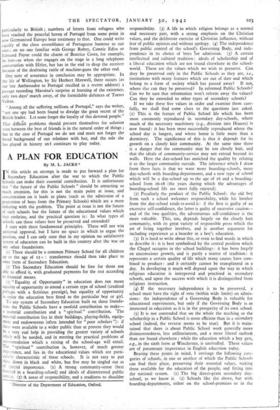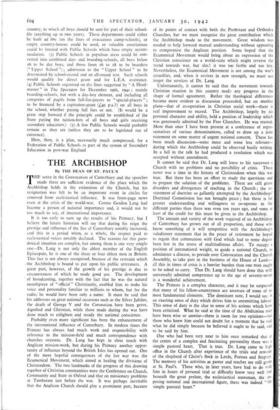A PLAN FOR EDUCATION
By M. L. JACKS*
IN this article an attempt is made to put forward a plan for Secondary Education after the war to which the Public Schools can make their essential contribution. It is unfortunate that " the future of the Public Schools " should be attracting so much attention, for this is not the main point at issue, and concentration on it leads to plans (such as the admission of a proportion of boys from the Primary Schools) which are a mere tinkering with the problem. The point at issue is not the future of such schools but the future of the educational values which they enshrine, and the practical question is: In what types of schools can these values best be preserved and extended?
I start with three fundamental principles. These will not win universal approval, but I have no space in which to argue the position, and I can only state that in my opinion no satisfactory system of education can be built in this country after the war on any other foundations.
(I) There should be a common Primary School for all children up to the age of 12+ : transference should then take place to some form of Secondary Education.
(2) This Secondary Education should' be free for those not able to afford it, with graduated payments for the rest according to financial means.
(3) "Equality of Opportunity" in education does not mean equality of opportunity to attend a certain type of school (credited perhaps with a fictitious prestige), but equality of opportunity to enjoy the education best fitted to the particular boy or girl.
To any system of Secondary Education built on these founda- tions the Public Schools have a twofold contribution to make_ a material contribution and a " spiritual " contribution. The material contribution lies in their buildings, playing-fields, equip- ment and endowments (often intended for " poor scholars "): if these were available to a wider public than at present they would be a very real help in providing the greater variety of schools which will be needed, and in meeting the practical problems of accommodation which a raising of the school-age will entail. The " spiritual " contribution is, however, of much greater importance, and lies in the educational values which are parti- cularly characteristic of these schools. It is not easy to put these down in black and white, but five may be singled out as of special importance. (r) A strong community-sense (best fostered in a boarding-school) and ideals of disinterested public service. (2) A sense of responsibility, and a readiness to shoulder
' Director of the Department of Education, Oxford. responsibility. (3) A life to which religion belongs as a normal and necessary part, with a strong emphasis on the Christian values, and the deliberate exercise of Christian influence, without fear of public opinion and without apology. (4) The independence from public control of the school's Governing Body, and inde- pendence in its choice of boys 'tor admission. (5) A certain intellectual and cultural tradition : ideals of scholarship and of a liberal education which are not found elsewhere in the school- world. These are the values which we wish to preserve. Can
they be preserved only in the Public Schools as they are, i.e., institutions with many features which are out of date and which
belong to a form of society which has passed away? If not, where else can they be preserved? In reformed Public Schools? Can we be sure that reformation won't reform away the values? Can they be extended to other types of secondary schools?
If we take these five values in order and examine them care- fully, we shall find some dues to the questions just asked.
(i) This is the feature of Public School life which has been
most commonly reproduced in secondary day-schools, where much of the necessary machinery (e.g., division into Houses) is
now found: it has been most successfully reproduced where the school day is longest, and where home is little more than a dormitory. The significance of this is that it depends for its growth on a closely knit community. At the same time there is a danger that the community may be too closely knit, and that the ideals of community-service may not extend beyond its walls. Here the day-school has enriched the quality by relating it to the larger community outside. The inference which I draw from these facts is that we want more boarding-schools, more day-schools with boarding-departments, and a new type of school which will be a day-school up to the age of r6 and a boarding- school from 16-18 (the years during which the advantages of boarding-school life are most fully enjoyed).
(2) Peculiarly the product of the Public School : the old boy from such a school welcomes responsibility, while his brother from the day-school tends to avoid it : if the first is guilty of an excessive self-confidence, the latter is guilty of excessive caution— and of the two qualities, the adventurous self-confidence is the more valuable. This, too, depends largely on the closely knit community, with its great variety of responsible posts which the art of living together involves, and is another argument for including experience as a boarder in a boy's education.
(3) It is hard to write about this, or even to find words in which to describe it : it is best symbolised by the central position which the Chapel occupies in the school buildings : it has been largely an unconscious growth, and is partly a matter of tradition: it represents a certain quality of life which many causes have com- bined to produce: and it certainly cannot be transplanted in a day. In developing it much will depend upon the way in which religious education is interpreted and practised in secondary schools, and upon the success with which it is distinguished from religious instruction.
(4) If the necessary independence is to be preserved, a school must have the right of veto (within wide limits) on admis- sions: the independence of a Governing Body is valuable for educational experiments, but only if the Governing Body is as interested in education as it is in the prosperity of its own school.
(5) It is not contended that on the whole the teaching, or the scholarship in a Public School is more efficient than in a secondary
school (indeed, the reverse .seems to be true). But it is main- tained that there is about Public School work generally more disinterestedness, less utilitarianism, and a more liberal outlook . than are found elsewhere ; while the education which a boy gets, e.g., in the sixth form at Winchester, is unrivalled. These values are of paramount importance in English education today.
Bearing these points in mind, I envisage the following cate- gories of schools, in one or another of which the Public Schools can find their place, preserving their essential values, making these available for the education of the people, and fitting into the national system. (i) The big direct-grant secondary day- school, as we know it. (2) Schools like the above, but with boarding-departments, either on the school-premises or in the
country, to which all boys should be sent for part of their school- life (anything up to two years). These departments could either be built ad hTIC (on the lines of evacuation camp-schools), or empty country-houses could be used, or valuable associations could be formed with Public Schools which have empty accom- modation. (3) Public Schools in populous areas could be con- verted into combined day- and boarding-schools, all boys below 16 to be day boys, and those from 16 to 18 to be boarders
Upper School ") ; admission to the " Upper School " to be determined by school-record and an all-round test. Such schools would qualify for direct grant and for L.E.A. assistance. (4) Public Schools organised on the lines suggested by " A Head- master" in The Spectator for December 19th, 1941 ; mainly boarding-schools, but with a day-boy element, and including all categories of pupils from full-fee-payers to " special-placers " ; to be financed by a capitation-grant (£4o p.a.?) on all boys in the school, whether paying full fees or not. (It would be a great step forward if the principle could be established of the State paying the tuition-fees of all boys and girls receiving secondary education.) (5) A few Public Schools would probably remain as they are (unless they are to be legislated out of existence).
Here, then, is a plan, necessarily much compressed, for a Federation of Public Schools as part of the system of Secondary Education in post-war England.



























 Previous page
Previous page